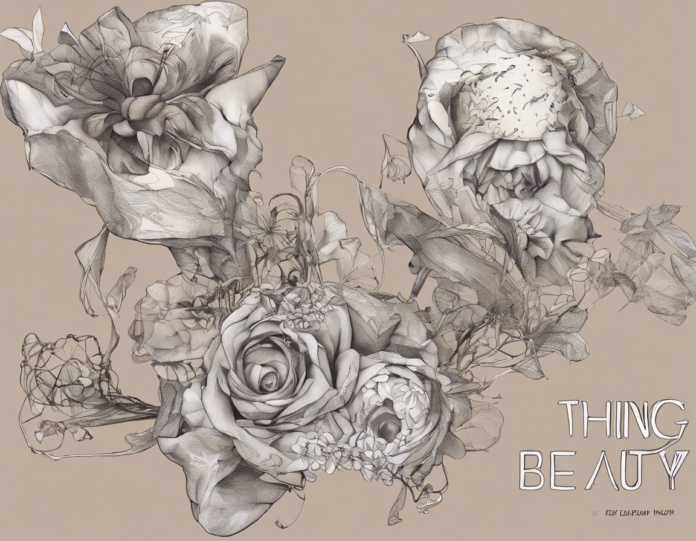Introduction
“A Thing of Beauty” is a poem written by John Keats, one of the greatest poets of the Romantic era. The poem is a celebration of beauty in its various forms and explores the idea that beauty is a powerful force that can bring joy and solace to the soul. In this blog post, we will delve into the depths of this poem, dissecting its themes, imagery, and language to uncover the beauty and meaning hidden within its verses.
Themes in “A Thing of Beauty”
One of the central themes of the poem is the transformative power of beauty. Keats opens the poem by declaring, “A thing of beauty is a joy forever.” This line sets the tone for the rest of the poem, as Keats goes on to describe how encounters with beauty can have a lasting impact on our lives. Beauty, in all its forms, has the ability to uplift our spirits, soothe our sorrows, and inspire us to see the world in a new light.
Another key theme in the poem is the idea of beauty as a source of solace and comfort in a chaotic world. Keats emphasizes the restorative power of beauty, portraying it as a refuge from the trials and tribulations of life. In a world filled with pain and suffering, beauty serves as a balm for the soul, offering moments of respite and transcendence.
Imagery and Language
Keats employs vivid imagery and rich language to evoke the beauty he describes in the poem. He uses sensory details to paint a picture of the natural world, with images of blooming flowers, melodious birdsong, and lush landscapes filling the verses. Through his lyrical descriptions, Keats invites the reader to immerse themselves in a world of beauty and wonder.
The language in the poem is also carefully crafted to enhance the themes of beauty and transcendence. Keats uses poetic devices such as alliteration, metaphor, and personification to bring the beauty he describes to life. For example, in the line “Therefore, on every morrow, are we wreathing a flowery band to bind us to the earth,” Keats personifies nature, portraying it as a gentle force that connects us to the world around us.
Analysis of Verses
Let’s take a closer look at some key verses from “A Thing of Beauty” to uncover their deeper meanings:
- “A thing of beauty is a joy forever: Its loveliness increases; it will never pass into nothingness.”
In this opening line, Keats asserts the eternal nature of beauty. He suggests that true beauty is not fleeting or transient but rather endures over time, growing more lovely with each passing moment. By emphasizing the lasting impact of beauty, Keats underscores its significance in our lives.
- “The sun, the moon, the trees, old and young, sprouting a shady boon.”
Here, Keats personifies the natural world, portraying the sun, moon, and trees as living beings that bestow blessings upon the earth. The image of the trees providing a “shady boon” evokes a sense of comfort and protection, highlighting the nurturing qualities of nature.
- “Therefore, on every morrow, are we wreathing a flowery band to bind us to the earth.”
Keats uses this line to convey the idea that beauty serves as a link between humanity and the natural world. The act of “wreathing a flowery band” suggests a ritualistic honoring of beauty, a way of paying homage to the earth and our place within it. By binding ourselves to the earth through beauty, Keats suggests that we can find a sense of belonging and connection in a world that can often feel isolating.
Frequently Asked Questions (FAQs)
- What is the main message of “A Thing of Beauty”?
-
The main message of the poem is that beauty is a powerful force that can bring joy, solace, and inspiration to our lives.
-
What does Keats mean by “a joy forever”?
-
Keats suggests that true beauty is everlasting and has the ability to bring joy that endures over time.
-
How does Keats use imagery in the poem?
-
Keats uses vivid imagery of the natural world to evoke the beauty he describes in the poem, creating a rich tapestry of sensory details.
-
Why does Keats emphasize the eternal nature of beauty?
-
Keats emphasizes the eternal nature of beauty to underscore its significance in our lives and to highlight its transformative power.
-
What role does nature play in “A Thing of Beauty”?
-
Nature plays a central role in the poem, serving as a source of solace, inspiration, and connection between humanity and the natural world.
-
How does Keats use language to enhance the themes of the poem?
-
Keats uses poetic devices such as alliteration, metaphor, and personification to bring the beauty he describes to life and to underscore the themes of beauty and transcendence.
-
What is the significance of the line “wreathing a flowery band to bind us to the earth”?
-
This line symbolizes the connection between humanity and the natural world through beauty, suggesting that beauty serves as a link that binds us to the earth and to each other.
-
How does “A Thing of Beauty” reflect the Romantic ideals of the era?
-
The poem reflects the Romantic ideals of nature, beauty, and emotion, celebrating the power of beauty to elevate the soul and transform the way we see the world.
-
What emotions does the poem evoke in the reader?
-
The poem evokes feelings of joy, wonder, and reverence for the beauty of the natural world, inviting the reader to contemplate the transcendent power of beauty.
-
What can we learn from “A Thing of Beauty” in our modern lives?
- The poem reminds us of the importance of finding beauty in the world around us, seeking solace and inspiration in moments of turmoil, and cultivating a deep appreciation for the wonders of nature.


